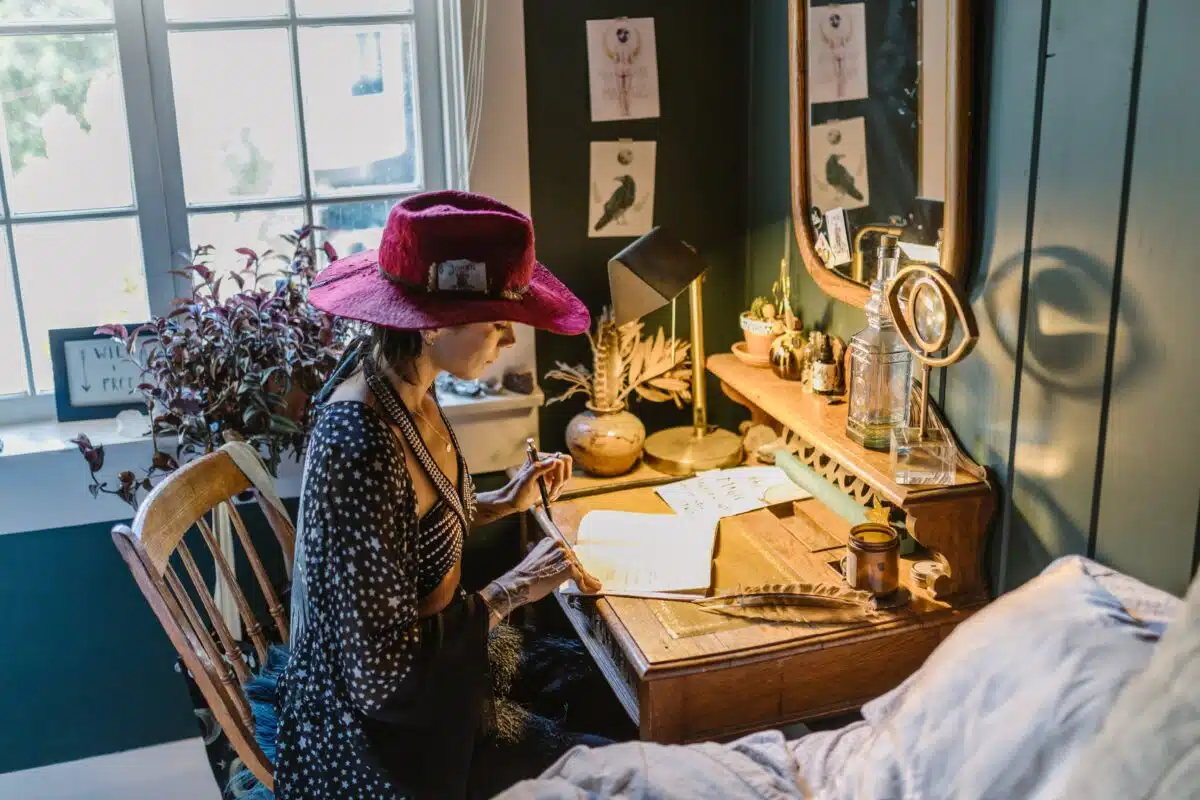Here’s what the Epyllion poetry form is:
The most basic definition of an epyllion is that it is a “short epic poem.”
Definitions beyond that vary depending on who you ask, though one of the most commonly agreed upon standards is that it should be in dactylic hexameter (some writers even consider this to be optional).
So if you want to learn all about the Epyllion poetry type, then you’ve come to the right place.
Let’s jump right in!
- Mimic Poetry Form: Unleash Your Inner Wordsmith
- Epithalamion Poetry Form: Ignite Love’s Triumph
- Anagrammatic Poetry Form: Puzzle Your Thoughts
- Patchwork Poetry Form: Stitch Words of Wonder
- Cento Poetry Form: Inspire With Melodic Blend

Forms of Poetry: Epyllion

An epyllion is essentially a short epic poem, though there are some implied differences.
It’s generally agreed that an epyllion does not necessarily need to have the same themes and techniques exactly as a formal epic.
This definition is slightly betrayed, however, by a short delve into the origins of the term “epyllion.”
You see, the term “epyllion” actually has very little backing from the ancient sources to which it is supposed to be prescribed.
Only a single source from the time, written by Athenaeus of Naucratis, actually supports the modern definition of epyllion.
In the excerpt, he seems to be using the term interchangeably with “short epic.”
It’s entirely possible that it was just a coined term for that one work.
In reality, the modern concept of the form seems to have spread outwards from the efforts of Friedrich August Wolf.
This does not necessarily invalidate the term, however.
All words are made up to begin with, so whether or not they’re accurate to the ancient terminology is largely irrelevant from a modern lens anyway.
Whatever the case, the term stuck and is now a part of classical literature studies.
We could chalk it up to how desperate lovers of classical literature are to find new things to talk about after thousands of years of reading the same body of work, but that’s a discussion for another day.
Basic Properties of Epyllions

| Rhyme Structure | None |
| Meter | Dactylic hexameter |
| Origin | Ancient Greece |
| Popularity | Mostly dead; even the term’s origin is contentious at best |
| Theme | Narrative |
How Is an Epyllion Structured?

As you would expect from the term’s unusual origin story, there is also some contention about what does and does not qualify as an epyllion.
The general agreement, that it is a narrative poem similar to but shorter than a full epic, is largely the only part of the definition that remains a universal constant.
As such, you should assume that ALL of this section is the result of academics arguing over trifles in small rooms behind closed doors.
You could call Shakespeare’s The Rape of Lucrece an epyllion and you wouldn’t necessarily be totally wrong, depending on whose definition you’re going by, though it generally wouldn’t be considered an epyllion.
If you want to know everything about the most scholarly definition of epyllions, you’ll need to keep reading.
Scholars generally agree that such poems written in dactylic hexameter, at the very least, do qualify as epyllions.
Despite the name, the dactylic hexameter we’re referring to here is actually a mix of dactyls and spondees, not just six dactyls.
Trochees may also make rare appearances at the ends of lines.
A dactyl, as a reminder, is a three-syllable foot in which only the first syllable is long, and the remaining syllables are short.
In English poetry we would treat a dactyl as having a stressed syllable followed by two unstressed syllables, if the English terminology helps you to understand more easily.
A spondee, meanwhile, is a two-syllable foot in which BOTH syllables are stressed.
Spondees are quite rare in English when speaking naturally.
Compound words such as “toothache” and “airport” account for the majority of spondees you would come across in natural speech, though not all compound words are spondees.
There will be six feet on every line in dactylic hexameter.
This part is not negotiable.
The first five syllables are a mix of dactyls and spondees in any order, though the fifth foot is usually a dactyl.
The final syllable is always a spondee or trochee (two-syllable foot: long, then short).
The other major structure of epyllions, which is not as agreed upon, is those poems that are written entirely in elegiac couplets.
An elegiac couplet contains one line in dactylic hexameter and a second line in dactylic pentameter.

Lines written in dactylic pentameter are split essentially into two halves.
The first half of the line is two feet that are either dactyls or spondees followed by a single long syllable, while the second half is the same structure, but the feet can only be dactyls.
Note that the last syllable of the line can technically be long or short.
This actually comes down to the same reasoning as the random optional trochee in a line of dactylic hexameter.
There’s a phenomenon in classical poetry called brevis in longo, which allows a final short syllable to be read as a long syllable.
As such, that “trochee” mentioned above is technically a spondee from the academic perspective, but it might be easier to remember it as an optional trochee.
Note that elegiac couplets were/are largely functionally similar to the heroic couplets in other languages; self-contained couplets that are usually chained back-to-back in narrative poems.
Personally, I would argue that there’s no substantial reason an epyllion in elegiac couplets would be any less valid than one written in dactylic hexameter but do be aware that there’s disagreement among scholars. (Scholars disagreeing about something? Shocking.)
Naturally, that’s not the only disagreement.
There’s also contention over what qualifies as “short.”
If a poem would have spread out across multiple scrolls, then where exactly do we draw the line?
What word count qualifies as “a short epic?”
As you can imagine, the ONE usage of the term from a valid ancient source that we have at our disposal did not go over the exact word count you could check in Microsoft Word to figure out whether your poem qualifies as an epyllion or not.
The difference is ultimately a petty one if we’re being honest.
Short is subjective.
Epyllions often feature allusions and vivid descriptions, but these were also common traits among Greco-Roman narratives in general.
There’s a valid argument to be made that this was simply how things were written at the time.
Example of Epyllion

From Evangeline by Henry Wadsworth Longfellow
This is the forest primeval. The murmuring pines and the hemlocks,
Bearded with moss, and in garments green, indistinct in the twilight,
Stand like Druids of eld, with voices sad and prophetic,
Stand like harpers hoar, with beards that rest on their bosoms.
Loud from its rocky caverns, the deep-voiced neighboring ocean
Speaks, and in accents disconsolate answers the wail of the forest.
I would like to stress that the above excerpt is not actually from an epyllion.
But since there’s no line-by-line structural difference between an epic and an epyllion, I decided it would suffice to show off the intended meter of the form.
Evangeline is an epic poem written in dactylic hexameter.
If you read it out loud, you may notice that the cadence of the poem feels somewhat ‘off.’
English speakers famously trend toward iambs and anapests in natural speech, especially because of the usual placements of articles and prepositions.
As such, writing a poem in any variant of dactylic meter requires a significant amount of wordplay.
When speaking, we wouldn’t actually say phrases like “forest primeval” or “in garments green,” but similar compromises are often necessary to make a meter work.
This is one of the reasons that iambic meter, which usually requires the least compromises, has been so popular historically.
Tips for Writing an Epyllion

First, how much do you value your sanity?
While an epyllion will naturally be much less demanding than an epic, due to its relative brevity, we’re still talking about writing dozens of lines in a meter that feels largely unnatural to native English speakers.
The challenge of an epyllion does not come at all from the narrative or the line lengths, both of which offer plenty of flexibility in how they are handled.
It comes almost entirely from the meter in this case, and from how your syntax will feel more and more strained as the poem goes on.
On top of that, epic poems aren’t especially popular in this day and age, long or short.
We live in an era of cheaply written haikus and grammarless Instagram poems that go viral.
You’ll accomplish more commercial success from SEO and careful thumbnail selection than you will from impressing scholars.
As such, the only merit to picking up such a tense and challenging form is if you, yourself, want to embrace the difficulty level.
If you are at that point, then odds are that you don’t need much advice.
If you’re not at that point, don’t start with dactyls.
Learn iambs, then trochees, then anapests, then maybe dactyls if you’re feeling spicy.
Greek meters weren’t designed for the English language, after all.
They were designed, unsurprisingly, for Greek.
After you chew through a thorough study of at least three other easier meters, then I think you’ll be ready for dactyls.
Poet’s Note

I would love to know how a single usage of a single word in a single paragraph preserved across thousands of years turned into this.
I cannot stress enough that all of this is only an aftereffect of scholars discussing a term that ancient people may not have even actually used outside of that one specific instance.
Athenaeus may have just added a suffix to a word and rolled with it for all we know.
Comprehensive Collection of Poetry Forms: Craft Words Into Art

Dare to traverse the entire spectrum of poetic forms, from the commonplace to the extraordinary?
Venture from the quintessential Sonnet to the elusive Mistress Bradstreet stanza, right through to the daunting complexity of Cro Cumaisc Etir Casbairdni Ocus Lethrannaigecht.
For those with a zeal to encounter the full breadth of poetry’s forms, this invitation is yours.
Start exploring the vast universe of poetic ingenuity with our comprehensive array of poetry forms right now!
